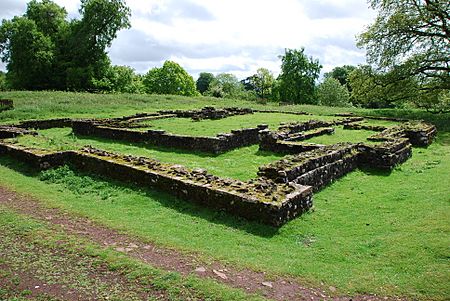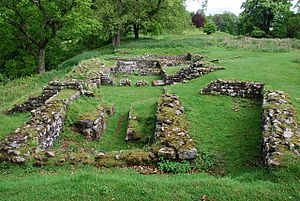Nodens facts for kids

Nodens or Nodons is an ancient Celtic god from Britain. People worshipped him as a god of healing. We don't have any pictures of him from ancient times. However, special plaques found at a shrine in Lydney Park in Gloucestershire show he was linked to dogs. Dogs were often seen as symbols of healing long ago.
Nodens is known from only one other place, in Cockersand Moss in Lancashire. He was often linked to the Roman god Mars, but as a healer, not a warrior. He was also connected to Silvanus, a hunting god, in a curse. His name is similar to other Celtic figures, like the Irish Nuada and the Welsh Nudd.
The famous writer J. R. R. Tolkien was asked to study an old Latin message about Nodens. Scholars believe this god and the site influenced Tolkien's fantasy world, Middle-earth. For example, the Elvish craftsman Celebrimbor, who made the Rings of Power, has a name meaning 'Silver-hand'. This is similar to Nuada's nickname, Airgetlám, which also means 'Silver-hand'. Nodens also appears in the stories of H. P. Lovecraft, known as the Cthulhu Mythos.
Contents
What's in a Name? The Origin of Nodens
The name Nodens comes from an older Celtic word, *Nowdont-. It's like a language cousin to the Irish name Nuadu and the Welsh name Nudd. These names are all connected.
The meaning of Nodens' name isn't fully clear. Some experts think it might mean 'mist' or 'haze'. This idea comes from the Welsh word nudd, which means 'mist'. Both Lludd and Nuadu are known for having a 'silver hand' or 'silver arm'. This could link to the idea of mist or clouds.
Other ideas suggest the name is about 'catching' or 'acquiring'. This might connect Nodens to fishing or hunting, which were important at the Lydney site.
Nudd's son, Gwyn, means 'white'. He ruled the Welsh Otherworld. His name is like the Irish name Finn. Some believe Nodens was a powerful god. He might have been a shining warrior who controlled wild things in nature and the spirit world.
The name "Lydney" where the temple was found, might mean "Lludd's Island". This would connect the place directly to Nodens. However, there are other ideas about where the name Lydney came from.
Ancient Clues: Inscriptions at Lydney Park

The temple at Lydney Park sits on a hill overlooking the Severn Estuary. It's a large, rectangular building. Inside, there was a main hall. This temple was likely a place where sick people could sleep. They hoped to have a dream where the god would appear and heal them. The location might have been chosen because it had a clear view of the River Severn. It was also built inside an older Iron Age fort.
Archaeologists first explored the temple in 1805. Later, in 1928–1929, Sir Mortimer Wheeler and Tessa Wheeler did more digging. They found many interesting things. Even though no statues of Nodens were found, twelve dog figures were discovered. People probably left these as gifts, hoping for healing. One dog figure even had a human face. This suggests Nodens might have been seen as an animal. A bronze arm found there had spoon-shaped fingernails. This is a sign of iron deficiency. This finding further supports Nodens' role as a healing god.
Other discoveries included bronze pictures of a sea god, fishermen, and mermaids. They also found a bronze plaque of a woman, about 320 pins, nearly 300 bracelets, and over 8,000 coins. Stamps used for eye ointment were also found. These were common at Roman healing sites. Nodens was also linked to water and the sun, like other healing gods of that time.
The Curse Tablet
Several messages to Nodens were found. One was on a lead tablet, called a curse tablet. It read:
|
Devo Nodenti Silvianus anilum perdedit demediam partem donavit Nodenti inter quibus nomen Seniciani nollis petmittas sanitatem donec perfera(t) usque templum [No]dentis Rediviva |
To the god Nodens: Silvianus has lost his ring. He has given half its value to Nodens. Among those named Senicianus, do not allow health until he brings it to the temple of Nodens.
(This curse) comes into force again. |
This tablet shows that someone named Silvianus lost a ring. He asked Nodens to make sure the person who took it, Senicianus, would not be healthy until the ring was returned to the temple.
Nodens and Mars
Other messages found at Lydney Park linked Nodens to the Roman god Mars:
| D(eo) M(arti) Nodonti Flavius Blandinus armatura v(otum) s(olvit) l(ibens) m(erito) | To the god Mars Nodons: Flavius Blandinus, a weapon-instructor, gladly and deservedly fulfilled his promise. |
| Pectillus votum quod promissit deo Nudente M(arti) dedit | Pectillus gave to the god Nudens Mars the offering he had promised. |
| D(eo) M(arti) N(odenti) T(itus) Flavius Senilis pr(aepositus) rel(igionis?) ex stipibus pos{s}uit o(pitu)lante Victorino interp(re)tiante | To the god Mars Nodens: Titus Flavius Senilis, who was in charge of the cult, had this mosaic laid using offerings. Victorinus the interpreter helped him. |
These inscriptions show that people saw Nodens as a healing god, even when they linked him to Mars, who was usually a god of war.
Another Discovery: Cockersand Moss
In 1718, a small silver statue was found in Cockersand Moss, Lancashire. This statue is now lost. But it had a message on its base:
| D(eo) M(arti) N(odonti) Lucianus colleg(ae) Aprili Viatoris v(otum) s(olvit) | To the god Mars Nodons: Lucianus fulfilled the vow of his colleague, Aprilius Viator. |
Another message from the same area read:
| Deo Marti Nodonti Aurelius ...cinus sig(illum) | To the god Mars Nodons: Aurelius ...cinus set up this statuette. |
Similar Stories: Mythological Parallels
Nodens has connections to other famous figures in Celtic myths:
Nuada of the Silver-Hand
Nuada Airgetlám was the first king of the Tuatha Dé Danann, a group of gods in Irish mythology. He lost his hand in a battle. Because of this, he couldn't be king anymore. But then, a doctor named Dian Cecht and a craftsman named Creidhne made him a working silver hand. This gave him the nickname Airgetlám, meaning 'silver hand'. Later, Dian Cecht's son, Miach, even gave him a real hand back.
Nudd and Lludd
The legendary Welsh hero Nudd is mentioned in the Welsh Triads. These are old Welsh lists of important people. Nudd was known as one of the three most generous men in Wales. His sons were Edern ap Nudd and Gwyn ap Nudd. Nudd is also sometimes called Lludd. He seems to be linked to other figures with the same name, like the son of Beli Mawr in the story Cyfranc Lludd a Llefelys.
Lasting Influence: Nodens' Legacy
Tolkien's Middle-earth

J. R. R. Tolkien was asked to study the Latin message at Lydney Park. He connected Nodens to the Irish hero Nuada Airgetlám, "Nuada of the Silver-Hand". The Tolkien expert Tom Shippey believed this was a very important influence on Tolkien's creation of Middle-earth. It brought together ideas of a god-hero, a ring, dwarves, and a silver hand.
Mathew Lyons noted that the mine-like holes at "Dwarf's Hill" (where the temple is) looked a bit like Hobbit holes. Tolkien was very interested in the local stories about the hill. Helen Armstrong suggested that the place might have inspired Tolkien's character Celebrimbor. It may also have inspired the fallen kingdoms of Moria and Eregion.
The name of the Elven-smith Celebrimbor from Eregion means "Silver Hand" in Tolkien's invented Elvish language, Sindarin. He was the one who forged the Rings of Power in The Silmarillion. Dwarf's Hill, with its many mine shafts, is thought to have influenced the Lonely Mountain in The Hobbit. It also influenced the Mines of Moria in The Lord of the Rings.
Lovecraft's Cthulhu Mythos
Nodens appears as a god in H. P. Lovecraft's Cthulhu Mythos stories. His role was based on a mix of Celtic and Roman myths. He also drew from how Nodens appeared in Arthur Machen's story The Great God Pan. Nodens first showed up in Lovecraft's 1926 story The Dream-Quest of Unknown Kadath. There, he is an "ancient" god served by creatures called night-gaunts. He is shown as somewhat kind and against the scary Nyarlathotep. Nodens also appears in Lovecraft's short story "The Strange High House in the Mist". In this story, the main character sees "primal Nodens, Lord of the Great Abyss" riding in a large shell carried by dolphins.
Paolini's Eragon
In Christopher Paolini's book Eragon, 'Argetlam' means 'silver hand'. It's another name for the gedwëy ignasia, which is a shining mark on the palm. This name is taken from the Irish word Airgetlam.

